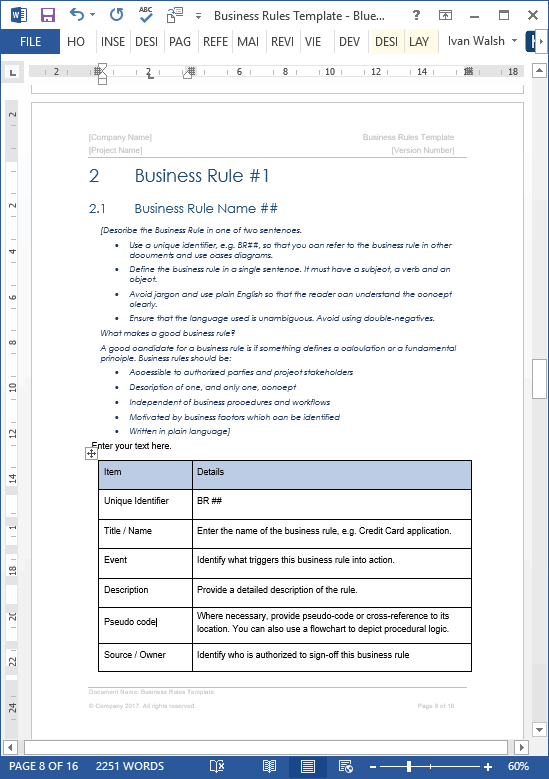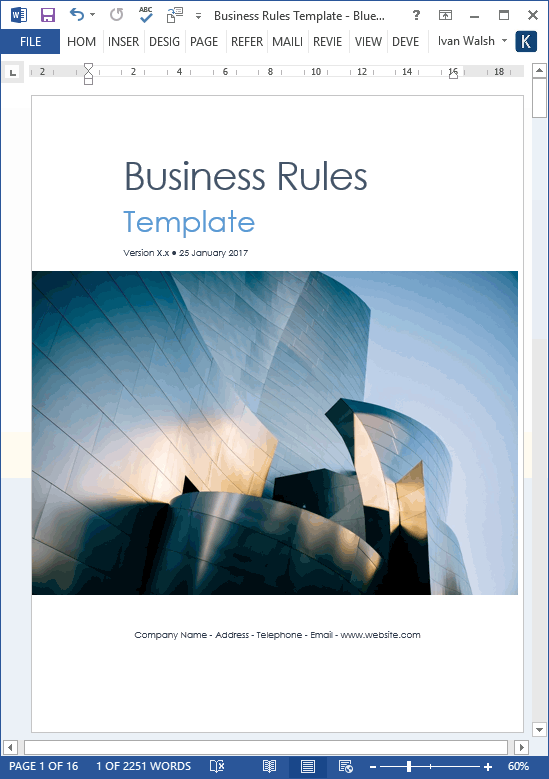Business Analysis Templates
How to Write Business Rules for Agile Projects
This tutorial describes how to write business rules for a software development project. These guidelines also apply to software testing, business analysis, and other scenarios where you need to define business rules for an IT system.
Learn More about this Business Rules template
What is a Business Rule?
A business rule is a rule that defines a specific constraint within the context of a business.
Business Rule Examples
Let’s say you’re developing an IT system for a bank. In addition to gathering technical requirements (the hardware, hosting, platform etc.) and user requirements (how customers will apply for loans, credit cards, etc.), you also need to consider the bank’s business rules.
Here’s an example.
When John applies for a credit card, the bank offers him a credit card application form, if he meets certain criteria.
In other words:
If the customer is over 18, has a valid identity, and has completed the application form correctly
Then give the customer a credit card
Else explain why they have been refused.
So, the structure of the business rule is essentially.
- If this is True
- Then do this
- Else do the other
- If, Then, Else are the three elements to consider when writing a business rule.
Business Rule Groups
Most business rules are part of a larger body of work, typically an overarching process model.
Think of a business rule as one rule in a large rule book.
The name of the rule book changes depending on the project management or business analysis methodology you’re using, but the idea is the same.
It’s also worth noting that business rules often overlap, cross-reference each other, and form part of larger business rule groups.
For example, you might have a business rule group for Credit Cards, another for Pensions.
Business Rule Structure
To create business rules, first specify the vocabulary that is required to express the policy, then represent the logic of the business policy as “if-then” statements.
Source: IBM
The typical structure of a business rule is as follows:
Constraint/Action:
Define the business rule using a single sentence as a declaration.Each business rule must have a Subject, Verb and an Object.
Write the business rule in language that is unambiguous and accurate.
Use words that have specific meaning within the business domain.
For example, in the banking world ‘online’ means that system is up and running, whereas for someone else, it might mean the internet.
Use Nouns for business entities or attributes.Use Verbs define the relationships between entities.If you have no Business Data Model, then create a Glossary.
Use unique Numbers to identify the rule.For sub-rules, use hierarchic numbering, such as 2.1, 2.2, 2.3 and so on.
Each rule sentence should begin with one of Constraint/Computation/Action:
BR 1.1 Constraint/Computation/Action: xxxxxxxxx
BR 2 Constraint/Computation/Action: xxxxxxxxx
BR 2.1 Constraint/Computation/Action: xxxxxxxxxA business rule typically consists of the following information, in the order specified:
- Definitions
- Conditions
- Actions
Definitions
At the beginning of the rule, set parameters that identify business terms by using easy to understand names.
Conditions
The conditions section of the rule contains the “if” statements.These statements define the conditions under which actions are completed. If the condition is true, the action is completed.A business rule can contain one or more condition statements.
Actions
The actions section of the rule contains the “then” statements.These statements define the actions that are taken when the conditions that are represented by the “if” statements are met. If the actions section contains more than one action, the actions are taken in the order in which they are written.
You can also include “else” statements in the actions section. These statements define what actions to take if the conditions are not met.

Download Business Rules Templates in Excel and Word.
Learn More about this Business Rules template

